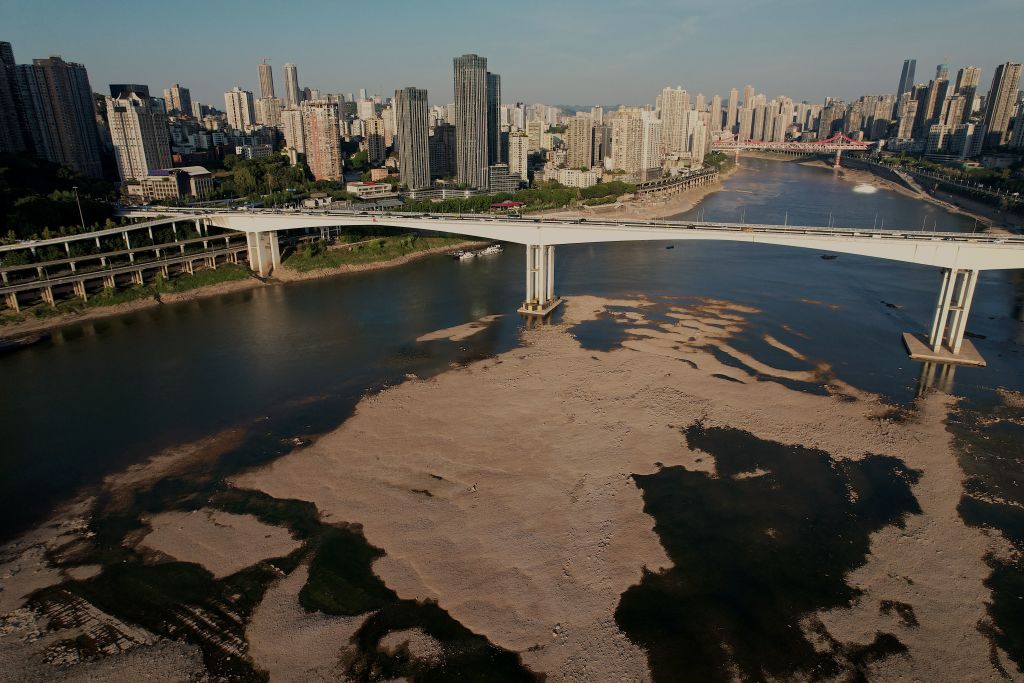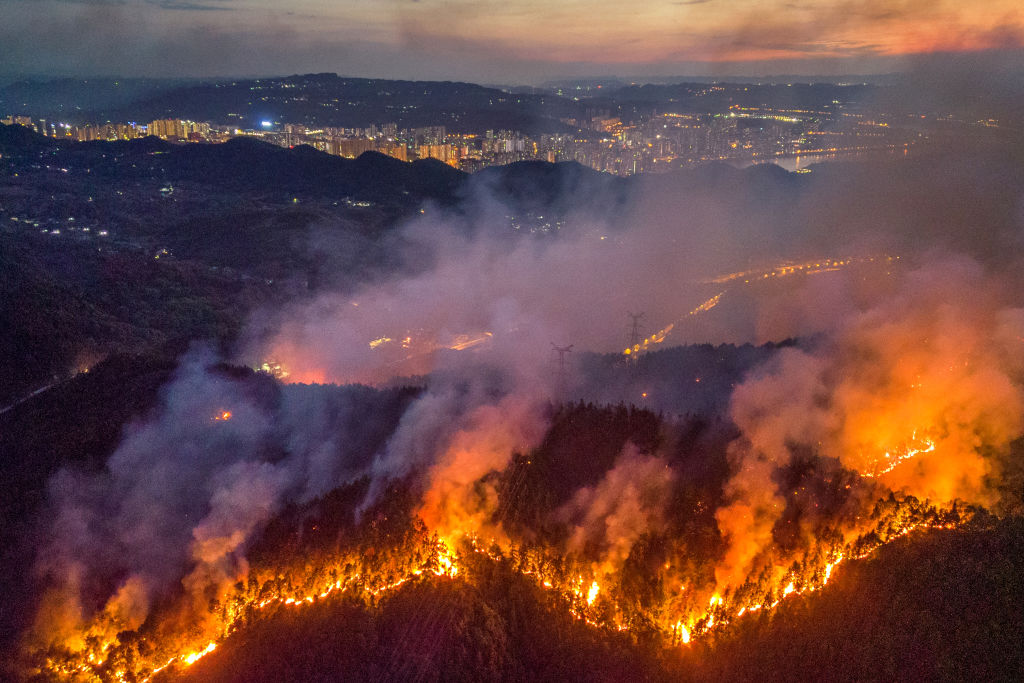
Extreme weather events have struck countries around the world this summer, and China is no exception. Forest fires erupted in the Southwestern city of Chongqing in late August amid a weeks-long heatwave—the worst the country has faced in decades. Record low rainfall has driven an unprecedented drought along the Yangtze, China’s longest river. Then suddenly this week, the same Southwest region that’s been devastated by scorching temperatures and drought for most of the summer, saw more than 100,000 people evacuated due to flood risk.
Like elsewhere in the world, weather made worse by climate change has put pressure on China’s energy system. Some environmentalists worry this will further prolong the world’s largest greenhouse gas emitter’s reliance on coal, which still makes up more than half of its energy mix.
The South China Morning Post estimates that the heat wave, which ravaged China for more than 70 days, affected more than 900 million people in at least 17 provinces, from Southwestern Sichuan to coastal Jiangsu and Zhejiang provinces in the East. Since July, provinces including Anhui, Jiangxi, Hubei, Hunan, Chongqing, and Sichuan have been affected by drought.
The drought dried up reservoirs by as much as half, crippling hydropower stations in Southwestern Sichuan province, where 80% of its electricity comes from hydropower. At the peak of the drought, Sichuan’s hydropower generation plummeted by more than 50%, according to an analysis for Carbon Brief by Lauri Myllyvirta, a lead analyst at the Helsinki-based Centre for Research on Energy and Clean Air (CREA). But the power crunch hasn’t just impacted Sichuan. The province is the largest producer of hydropower in the country, accounting for 30% of China’s hydroelectric generation, according to Reuters, and other provinces rely on its energy supply. This includes Shanghai, Zhejiang, and Jiangsu—all of which are responsible for a significant portion of China’s industrial output.

Officials ordered factories in Sichuan—including the plants of Toyota and the Chinese battery behemoth CATL—and some other provinces in central China to shut down completely or to limit production. In late August, the Bund—Shanghai’s iconic skyline area—went dark for a few nights to save power.
Read More: How Rising U.S.-China Tensions May Hurt Efforts to Fight Climate Change
The much needed rainfall in parts of Sichuan this week, however, won’t solve China’s energy woes. “Much of China’s hydropower capacity is built with very small or even no reservoirs, so the effect of rainfall is dramatic but not long-lasting,” says Myllyvirta, of CREA, which has been analyzing China’s energy situation. “The droughts will continue to affect hydropower output in the next few months, due to low water levels in reservoirs.”
This hydropower shortage has driven the perception among some people and officials in China that renewable energy sources, including hydropower, are not reliable, according to Li Shuo of Greenpeace East Asia, adding fuel to the argument that the country needs more baseload power, especially from coal—a fossil fuel which helps drive extreme climate impacts like drought.
In response to the energy crunch, coal power generation increased approximately 6% in July, Myllyvirta tells TIME via email. Across the country, power plants burned 15% more thermal coal each day for the first two weeks of August than a year ago, according to data from the National Development and Reform Commission compiled by CNN.
Coal production already hit record levels in 2021, following a country-wide energy crisis late in the year, the country’s worst in a decade. It was driven by a combination of high fuel prices and demand, a coal shortage, and efforts to enforce new emission reduction targets. In an attempt to avoid a repeat of those events, China mined 2.19 billion metric tons of coal between January and June, up 11% year-on-year, according to the National Bureau of Statistics. In June, as temperatures and electricity use skyrocketed, China’s premier Li Keqiang called for coal production to be ramped up to avoid mass blackouts.
“Last year really kind of changed the philosophy of China’s energy planning,” says Cosimo Ries, an analyst and energy expert at the consulting agency Trivium China. The lesson the country took away from it was “that energy security in the short term is more important than decarbonization.”

And energy security is more important than ever to Chinese President Xi Jinping, who has emphasized stability ahead of seeking a precedent-shattering third term at Chinese Communist Party meetings next month.
Of course, China isn’t alone in prioritizing energy security over decarbonization. Global competition for coal supplies drove the benchmark price of the dirty fuel to new records this year. Last month, Germany began reactivating coal-fired power plants—originally scheduled to be phased out to meet climate goals—as it weans itself off Russian energy sources. That’s despite a promise to eliminate coal use by 2030. And spiking energy demand during heat waves in India this summer prompted a government announcement that old mines would be reopened, and output increased.
It remains unclear if, or how, China’s current increase in coal production and consumption will have knock-on impacts on its climate targets. Beijing has pledged to peak its emissions before 2030, cut its coal use starting in 2026, and to reach carbon neutrality by 2060. China’s increase in coal output over the past year, however, hasn’t translated into a similar increase in coal use. In his analysis for Carbon Brief, Myllyvirta found that China’s coal-fired power generation declined by 4% year-on-year in the first half of 2022, and China’s carbon emissions fell by a record 8% in the second quarter of this year. “The more salient trends are the real estate slump, which is hitting industrial electricity demand, and strong growth in wind, solar, and nuclear power generation,” he tells TIME.
Read More: The Colorado River Drought Is a Cautionary Climate Tale
But Myllyvirta adds that the response to the most recent shortage will most likely include building new coal power plants in the parts of China impacted by recent events, as well as renewed efforts to improve the grid so that it “isn’t as reliant on building dedicated coal capacity in every single province to keep the lights on.”
Ries agrees that recent events may slow down the phase-out of coal-fired power in China. “While most of China’s top coal-fired utilities are not really building that much capacity anymore—they’re building renewables very aggressively, they’re trying to transition their whole portfolio—I think they’ll also realize that this can’t happen too quickly because of the inherent risks that come with it.”
Li at Greenpeace points out the climate impacts that China is experiencing may provide important impetus for the government to take action. “China is indeed not immune from climate impacts,” he says. Li says that the extreme weather events that have occurred in recent years, including deadly floods and this summer’s drought, may impact public opinion about climate action. “Because of the severity of the heat wave this summer, I think there is kind of a change in perception slowly happening among the Chinese public,” he says. “I think it’s slowly triggering a national awakening.”
More Must-Reads from TIME
- Cybersecurity Experts Are Sounding the Alarm on DOGE
- Meet the 2025 Women of the Year
- The Harsh Truth About Disability Inclusion
- Why Do More Young Adults Have Cancer?
- Colman Domingo Leads With Radical Love
- How to Get Better at Doing Things Alone
- Michelle Zauner Stares Down the Darkness
Write to Amy Gunia at amy.gunia@time.com